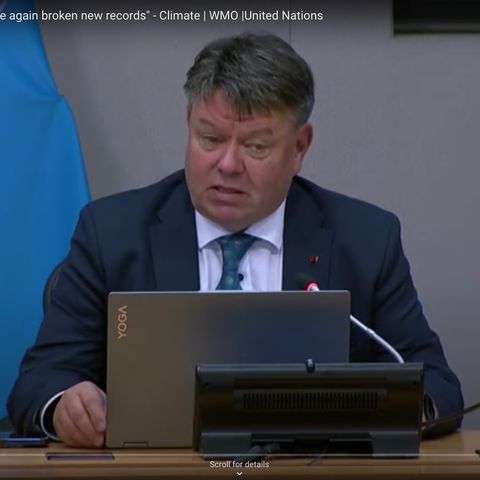UN WMO Greenhouse gas bulletin

Download and listen anywhere
Download your favorite episodes and enjoy them, wherever you are! Sign up or log in now to access offline listening.
Description
Press Conference by Mr. Petteri Taalas (WMO), on the launch of the WMO Greenhouse Gas Bulletin. Atmospheric levels of the three main greenhouse gases warming our planet - carbon dioxide,...
show moreAtmospheric levels of the three main greenhouse gases warming our planet - carbon dioxide, methane, and nitrous oxide- all reached new record highs in 2021, according to a new report from the UN’s World Meteorological Organization (WMO).
Addressing journalists in New York today (26 Oct), on the WMO Greenhouse Gas Bulletin, WMO’s Secretary-General Petteri Taalas said “we have again broken new records. So, we haven't seen any improvement in a real atmosphere so far.”
WMO’s Greenhouse Gas Bulletin reported the biggest year-on-year jump in methane concentrations in 2021 since systematic measurements began nearly 40 years ago. The reason for this exceptional increase is not clear but seems to be a result of both biological and human-induced processes. The increase in carbon dioxide levels from 2020 to 2021 was larger than the average annual growth rate over the last decade. Measurements from WMO’s Global Atmosphere Watch network stations show that these levels continues to rise in 2022 over the whole globe.
Between 1990 and 2021, the warming effect on our climate (known as radiative forcing) by long-lived greenhouse gases rose by nearly 50 percent, with carbon dioxide accounting for about 80 percent of this increase. Carbon dioxide concentrations in 2021 were 415.7 parts per million (ppm), methane at 1908 parts per billion (ppb), and nitrous oxide at 334.5 ppb. These values constitute, respectively, 149 percent, 262 percent, and 124 percent of pre-industrial levels before human activities started disrupting the natural equilibrium of these gases in the atmosphere., WMO UN Climate Change conference, COP27, in Egypt from 7-18 November.
Asked about the COP27, Taalas said, “It is important to get the whole G20 family on board because that group is responsible for 80 percent of global emissions.” The years from 2015 to 2021 were the seven warmest on record. The WMO reports seek to galvanize COP27 negotiators into more ambitious action decision-makers to achieve the Paris Agreement goal to limit global warming to well below 2, preferably to 1.5 degrees Celsius, compared to pre-industrial levels. The average global temperature is now more than 1.1°C above the 1850–1900 pre-industrial average. Given the need to strengthen the greenhouse gas information basis for decisions on climate mitigation efforts, WMO is working with the broader greenhouse gas community to develop a framework for sustained, internationally coordinated global greenhouse gas monitoring, including observing network design and international exchange and use of the resulting observations. It will engage with the broader scientific and international community, particularly regarding land surface and ocean observation and modeling. WMO measures atmospheric concentrations of greenhouse gases – what remains in the atmosphere after gases are absorbed by sinks like the ocean and biosphere. This is not the same as emissions. A separate and complementary Emissions Gap Report by UN Environment will be released on 27 October.
The Emissions Gap report assesses the latest scientific studies on current and estimated future greenhouse gas emissions. This difference between “where we are likely to be and where we need to be” is known as the emissions gap. As long as emissions continue, global temperature will continue to rise.
Atmospheric carbon dioxide reached 149 percent of the pre-industrial level in 2021, primarily because of emissions from the combustion of fossil fuels and cement production. Global emissions have rebounded since the COVID-related lockdowns in 2020. Of the total emissions from human activities during the 2011–2020 period, about 48 percent accumulated in the atmosphere, 26 percent in the ocean, and 29 percent on land. There is concern that the ability of land ecosystems and oceans to act as “sinks” may become less effective in the future, thus reducing their ability to absorb carbon dioxide and act as a buffer against larger temperature increase. In some parts of the world, the transition of land sink into CO2 source is already happening. Given the long life of CO2, the temperature level already observed will persist for decades even if emissions are rapidly reduced to net zero.
Informal comments to the media by Vassily Nebenzia, Permanent Representative of the Russian Federation to the United Nations, on the maintenance of international peace and security.
Information
| Author | Michael Clogs |
| Organization | Depictions Media |
| Website | - |
| Tags |
Copyright 2024 - Spreaker Inc. an iHeartMedia Company

Comments